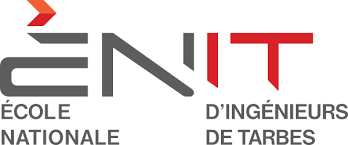Journée thématique "mécatronique et industrie du futur"
 Chaque présentation est télechargeable en cliquant sur l'icone
Chaque présentation est télechargeable en cliquant sur l'icone
 en dessous de l'horaire.
en dessous de l'horaire.
 Les PHOTOS de la journée sont disponibles au lien suivant
Les PHOTOS de la journée sont disponibles au lien suivant

Introduction :
Après quelques années de pause, le CT SYSME reprend ses activités avec une rencontre thématique : "mécatronique et industrie du futur". La rencontre aura lieu à
l'ENIT de Tarbes mais un lien est fourni pour celles et ceux qui souhaitent participer à distance.


Horaires :
Vendredi 30 septembre 2022, 8h30 à 16h45
Lieu :
Salle du Conseil
Ecole Nationale d'Igénieurs de Tarbes (ENIT)
47, ave d'Azereix
65000 Tarbes
Tél : 05 62 44 27 00
Lien zoom pour celles et ceux qui participent ou assistent à distance : le lien zoom n'est plus disponible (événement passé).
Programme :
8h30-8h45
Accueil salle du conseil ENIT Tarbes
8h45-9h00
Présentation de la journée par les animateurs
9h00-9h30
Présentation 
Mourad BENOUSSAAD,
Associate Professor
groupe MAVRICS, département SYSTEMES / LGP,
Ecole Nationale d'Ingénieurs de Tarbes
Title: "physical Human-Robot Interaction for Object Co-manipulation : Toward an Increasing Consideration of human system modeling and estimation"
Abstract:
Physical Human-robot Interaction is a promising and challenging robotics field, however this synergy requires to be improved to achieve a most complex tasks. One of these complexe tasks can be a co-manipulation (between human and robot) of heavy, bulky or flexible object which can be a product, a tools or another human. Therefore, to a consider a certain number of issues related to the interaction stability, safety and human ergonomics and comfort, the human should be considered more deeply as system than just an external perturbation force.
9h30-10h00
Présentation 
Kamal MEDJAHER,
Full Professor
groupe PRiSM, département SYSTEMES / LGP,
Ecole Nationale d'Ingénieurs de Tarbes
Title: "Prognostics and Health Managements (PHM) of industrial systems"
Abstract:
The presentation deals with Prognostics and Health Managements (PHM) of industrial systems. It summarizes the main concepts, definitions and tools used in the domain. It starts with the context and motivation about the utilization of PHM, recalls the main steps of PHM (condition monitoring, anomaly detection, fault detection, diagnostics, prognostic, decision support), explains the difference between PHM and Predictive Maintenance, presents an example of a data-driven prognostics approach and finishes with some case studies.
10h15-10h45
Présentation 
Gilles TAGNE,
Enseignant Chercheur
Laboratoire CRIStAL, équipe SoftE,
JUNIA Lille
Title: "Conception intégrée d'un système de systèmes robotique pour la gestion de la chaîne d'approvisionnement d'une usine 4.0"
Abstract:
De nos jours, les systèmes à grande échelle, robots et cobots, sont de plus en plus impliqués dans différents environnements de vie. Ces systèmes cyber-physiques autonomes et hétérogènes fonctionnent généralement de manière isolée les uns des autres et doivent être amenés à collaborer pour réaliser une ou plusieurs missions communes ; on parle alors de Système de Systèmes (SoS).
L'ingénierie des systèmes de systèmes (SoSE) est en pleine croissance mais reste encore à développer, notamment dans le domaine de l(industrie 4.0. Dans ces travaux, nous proposons une méthode de conception intégrée de système de systèmes permettant de garantir la résilience et un contrôle optimal pour la réalisation d'une tâche donnée tout en résolvant les problèmes d'interopérabilité de modèles des différents systèmes. Cette approche consiste à concevoir le SoS en plusieurs étapes en en utilisant différents outils de l'ingénierie des systèmes (SE) les plus appropriés à chaque étape de la conception.
Pour montrer le gain de l'approche proposée, une application autour de l'industrie 4.0 a été développée et testée. Les résultats préliminaires semblent prometteurs.
10h45-11h15
Présentation 
Thibaut RAHARIJAONA,
Full Professor
Laboratoire de Conception Fabrication et Commande,
Ecole Nationale d'Ingénieurs de Metz
Title: "Wood dust collection during robotic machining "
Abstract:
The wood dust produced during machining processes may influence machines and loss performance or cause a huge amount of diseases, from respiratory diseases to cancer. Centralized aspiration systems have become mandatory in the wood industries. Thus, wood dust extraction during machining is a critical issue. We propose to analyze the motion of wood dust near the tool in order to maximize the amout of dust collected.
11h30- 12h30, Invited Talk title:
"EcoMechatronics: A new paradigm supporting sustainability"
Présentation

ABSTRACT of the TALK
The concept of sustainability in the application and operation of engineering systems is of increasing significance in relation to the requirements for the mitigation
of climate change along with achieving global targets for the reduction of emissions of all types of greenhouse gasses.
As a major contributor to the design and operation of many current systems, mechatronics has a great deal to contribute to achieving many of the climate oriented
goals that have been identified. This has in turn led to the development of the concept of EcoMechatronics in which the approaches to the design and operation of
mechatronic systems which have evolved over the years are modified to encompass consideration of the issues of sustainability and environmental impact.
EcoMechatronics contributes to improved productivity, better environmental performance, the introduction of more energy-efficient machinery, reduced energy costs
and reduced environmental impact along with more effective management of waste and recycling with less material usage and waste, enhanced environmental
sustainability and safety with high user comfort. Examples from research projects with focus on Energy-flexible factory and design of small power trains will be further presented.
Reference: Hehenberger P, Habib M., Bradley D. (2022): "EcoMechatronics: Challenges for Evolution, Development and Sustainability", Springer Berlin Heidelberg,
https://link.springer.com/book/9783031075544
BIO
Dr Peter Hehenberger is Professor for Integrated Product Development, Head of the "Smart Mechatronics Engineering" Research Group and Academic Director of the
"Institute for Agile Transformation" at the School of Engineering, University of Applied Sciences Upper Austria, Wels/Austria. He completed his Diploma and Doctorate in Mechatronics from Johannes Kepler University JKU Linz /Austria in 2000 and 2004, respectively. In 2016 he received the post-doctoral lecturing qualification (venia docendi) for the subject area "Engineering Design".
Core research interests cover "Sustainability in Development and Production of Mechatronic Systems and "Engineering Processes" along with topics on "Digital Transformation".
He has published over 140 peer-reviewed papers in international journals and conference proceedings and been guest editor for three journal special issues. In addition,
he has authored or co-authored six books related to his research field. He serves as an Editorial Board Member for the "IFAC Journal Mechatronics", "Computer-Aided Design and Applications"
and "International Journal of Product Lifecycle Management" (IJPLM). Dr Hehenberger is active in the research community where he is refers to his research area of
"Mechatronic Design" as group member of IFIP WG5.1 "Global Product development for the whole life-cycle" and IFAC TC 4.2 "Mechatronic Systems". In 2015 he was invited as Visiting Professor at the Universite de Technologie de Compiegne, Departement Genie des Systemes Mecaniques, France.
14h00-14h30
Présentation 
Kevin SUBRIN,
Associate Professor
LS2N,
Université de Nantes
Title: "Transparency Analysis of a Passive Heavy Load Comanipulation Arm"
Abstract:
For collaborative robotics applications, many systems have addressed general handling issues in recent years. Depending on the industrial context,
these systems bring physical and cognitive feelings that result in the acceptance of their users. Transparency qualifies the ability of a robot to follow
the movements imposed by the operator without noting any resistant effort. The present work is to develop a methodology that mixes the approach highlighting
the human factors and their correlation to robotic criteria in the case of a passive manipulation arm with six degrees of freedom produced by the Neoditech company.
An exploratory study was then conducted to measure criteria such as time, speed, and effort during manipulation along with criteria based on a technological level,
personality and technology acceptance model-method questionnaires. From there, we uncovered a correlation between the user's personality, particularly their lack of neuroticism,
and their means of evaluating the device through its usefulness, comfort, and indicators of mechanical behavior. This study is a preliminary analysis of user behaviors and
traits that affect technological acceptance when dealing with a comanipulation arm. This work offers a framework for similar future analyses and recommends mechanical adjustments
to the arm for increased user acceptance.
14h30-15h00
Présentation 
Paul-Etienne VIDAL (Full Professor) et
Baptiste TRAJIN (Assoc Professor)
groupe e-ACE2, département SYSTEMES / LGP,
Ecole Nationale d'Ingénieurs de Tarbes
Title: "De la conception d'un capteur intégré, à la simulation du comportement dynamique macroscopique de son environnement."
Abstract:
Cette présentation s'appuie sur la vision pluridisciplinaire de l'équipe e-ACE2 dans ses
travaux de conception et de simulation, des assemblages d'électronique de puissance notamment. Dans cette présentation nous aborderons plus
spécifiquement la conception d'un capteur de courant de type boucle de Rogowski intégré à l'assemblage d'un module de puissance,
le traitement des informations mesurées et leur utilisation potentielle à des fins de caractérisation dynamique, numérique ou expérimentale,
ou encore à des fins d'observation et d'estimation avec un objectif de diagnostic. La discussion détaillera des caractéristiques physiques et virtuelles du capteur,
et proposera une discussion sur l'approche mécatronique que nous manipulons partant de l'objet physique jusqu'à son exploitation dans des simulations de systèmes macroscopiques.
15h15-15h45
Présentation 
Adrien KOESSLER,
Associate Professor
Laboratoire de Conception Fabrication et Commande,
Ecole Nationale d'Ingénieurs de Metz
Title: "Multi-robot Shaping of Deformable Objects based on Mechanical Simulation"
Abstract:
Addressing the manipulation of deformable objects by robotic arms is an issue for industrial applications. We focus on the shaping task, which consists in giving a desired shape to a deformable object grasped by two robotic arms.
15h45-16h15
Liseth Pasaguayo (
PHD Student),
Noureddine ZERHOUNI and Zeina AL MASRY
(
FEMTO-ST Institute),
Sergio LESCANO (Amarob Technologies company)
Title: "Critical components' identification of a microgripper for intracorporeal surgeries"
Abstract:
The development of microscale medical devices has had great growth in recent years in many
medical areas. Their main applications and contribution have been reflected in minimally invasive
surgery (MIS) and biomedical applications.
Despite the advantages that these micro devices bring, their development represents a great
challenge due to miniaturization. Prognostics and Health Management (PHM) approach is widely
used to study the health state of the systems. However, the application of PHM for micro medical
devices is a big challenge since they are made up of multiple components which are complex.
Prognostics approaches for complex microsystems should be oriented towards identifying critical
components and monitoring them individually.
This work is focused on critical component identifications of a microgripper for PHM
implementation. The microgripper is made up of four components and four steel wires of 0.08 mm
in diameter. A risk analysis is performed according to the requirements of ISO standard 14971 for
medical devices, and the Failure mode and effect analysis (FMEA) technique is used in order to
select critical components.

 Chaque présentation est télechargeable en cliquant sur l'icone
Chaque présentation est télechargeable en cliquant sur l'icone
 en dessous de l'horaire.
en dessous de l'horaire. Les PHOTOS de la journée sont disponibles au lien suivant
Les PHOTOS de la journée sont disponibles au lien suivant



